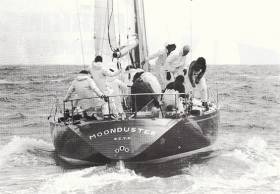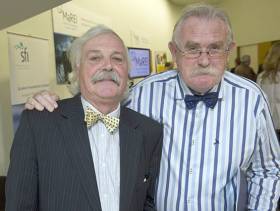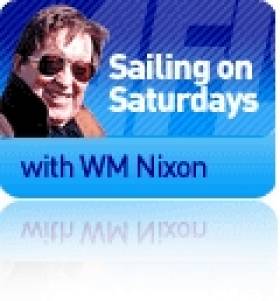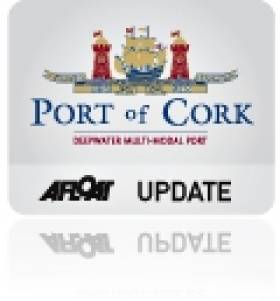Displaying items by tag: Seascapes
Hello and welcome aboard this week’s edition of your maritime programme Seascapes .....this week we hear about efforts afoot to assist in the restoration of “Moonduster”; we have the results of our recent competition for copies of Carsten Kriegers ‘ “This Is the Burren” courtesy of The Collins Press ; we talk to Donal Boland whom we met last weekend in Athlone whilst we were at The Dive Ireland Conference about a gathering in Lynches of Tullamore this weekend focussing on The Mid Shannon with a wide range of speakers; how the British Ambassador to Ireland HE Mr Dominick Chilcott earlier this week paid homage to Sir Ernest Shackleton and members of the Imperial Trans Antarctic Expedition and the Centenary of their return home with Tom Crean and our many maritime heroes celebrated by author Michael Smith who addressed the large gathering in the Ambassadors’ residence with descendants of the Shackleton and Crean families present, the Shackleton Mueseum in Athy and all branches of the forces including Chief of Staff of The Defence Forces – Vice Admiral Mark Mellett just returned from Mali..... ....first this week to last weekend’s Skipper Expo in Galway – Seascapes was there on Saturday where we met many regular listeners and contributors – one man whom I remember reading as a young boy was there, the veteran journalist and founding editor of The Skipper now in his eighties Arthur Reynolds had this to say....
Read also WM Nixon: Why Moonduster Should Not Make Ireland Her Home After Restoration
Seascapes Podcast – Ocean Energy Father Honoured
Hello and welcome aboard this week’s edition of your maritime programme ... this weekend on Saturday and Sunday - Dive Ireland 2016 the Annual conference hosted by the Irish Underwater Council and Athlone Sub Aqua takes place in the Hodson Bay Hotel in Athlone with a panel of experts speaking on a wide range of topics and a large selection of exhibitors showing their wares; also in Galway the Skipper Expo which began earlier today runs until Saturday afternoon in the Galway Bay Hotel in Salthill – Seascapes will be attending both events and hope to meet up with you there...
First on Seascapes this week... to an event held in the maritime hub of Cork Harbour earlier this week – titled the Lewis Symposium the two day event honoured Emeritus Professor Tony Lewis of University College Cork considered to be the father of Ocean Energy in this country ...let’s hear first from Professor Sarah Culloty of University College Cork, Head of School of Biological, Earth and Environmental Sciences and Director- Environmental Research Institute...
Ocean Energy, Angling & Fishing Expo in Seascapes Podcast
Hello and welcome aboard this weeks edition of your maritime programme, we have music from Molgoggers, we preview the Lewis Symposium presented by MaREI – Ocean Energy; Theory, Practice and Integration hosted by the Environmental Research Institute Beaufort Building, University College Cork by visiting the Seascapes archive and hearing from Emeritus Professor Tony Lewis ....the remarkable HMS Caroline the Battle of Jutlands only afloat survivor in Belfast soon to open as a heritage visitor attraction, Fergal Keane visits the annual Angling Expo in the National Show Centre held last weekend ..... and our competition for copies of “This Is the Burren” by photographer Carsten Krieger courtesy of The Collins Press; ....First here on Seascapes to the Raidio na Gaeltachta Studios in Derrybeg near Gweedore to hear from Hugh Bonner of Mara Media who publish The Irish Skipper and host the Skipper Expo with over one hundred exhibitors in Galway next weekend on Friday 4th and Saturday 5th March at The Galway Bay Hotel...
The Winter lecture 2015/16 season of the Glenua Sailing Centre continues with a double lecture programme at the March meeting entitled: ‘The Sea From Two Perspectives’.
The illustrated lectures will take place on next Thursday 3 March (20:00hrs) at the Poolbeg Yacht & Boat Club, Ringsend, Dublin. There will be an entry fee of €5 in aid of the R.N.L.I
The first lecture, “Art and The Sea - An Enduring Fascination” will be given by Jessica O’Donnell who is Collections Curator at Dublin City Gallery The Hugh Lane. Jessica is a graduate of Trinity College, Dublin and the University of St Andrews.
Jessica’s talk will explore how artists have been captivated by the sea from many perspectives including how the Impressionists loved portraying people at leisure by the sea; how safeguarding the freedom of the seas was represented in artworks commissioned as war time propaganda; to contemporary artists whose fascination with the sea and marine life continues to inspire.
The second lecture is entitled, “Putting Eyes In The Deep Ocean” by Dr Fiona Grant, Ocean Science & Information Services (OSIS), Marine Institute, Ireland. Fiona began her studies in geology before going on to specialise in marine geophysics and earth system dynamics. Her first job was as conservation coordinator for wild salmon and sea trout before taking responsibility for research infrastructures in the Marine Institute.
Dr Fiona Grant will focus on some of the challenges in observing the deep ocean environment, how to harness ocean energy in Galway Bay and present some of the latest results from studies in the Atlantic Ocean.....
The annual Ireland Angling Show was held in the National Show Centre in Swords in Dublin last weekend. ..........Fergal Keane went along for Seascapes.
Hi Marcus,
It's nearly 3 years since you put out a call on Seascapes to help us find people who had built IDRA 14 dinghies in the past or had plans that we didn't know about.Well, we're now coming towards the end of our project! We did meet with some listeners to your programme, who got in touch during that time and visited our project. Thought you might like to know how we're doing.
As we enter into the 70th anniversary year of the IDRA 14 Dinghy, we're delighted to be able to announce the launch date for the new wooden clinker-built IDRA 14 dinghy, being built in Clontarf, the first to be built in well over 35 years.
Look at it now............Riveting completed, floor bearers in place, spinny shute in place, foredeck on - we're ready now to put the deck on and close up the boat! :-) Find out more in our latest update.
Next to Emeritus Professor Tony Lewis of University College Cork , back in October of last year we were in Croke Park for an Ocean Energy Conference and we spoke to Tony ...
On Monday and Tuesday the Environmental Research Institute Beaufort Building hosts MaREI –The Lewis Symposium on Ocean Energy : Theory Practice and Integration at the National Maritime College of Ireland .....speakers will include Professor Tony Lewis ; Eoin Sweeney on Marine Renewables in Ireland ; Professor Stephen Salter , Emeritus Professor University of Edinburgh ; Professor Trevor Whittaker , Queens University Belfast on the Industrial History of Ocean Energy and Professor Alistair Borthwick , University of Edinburgh on tides and Tidal Power , we’ll have more detail on the speakers and topics at the Lewis Symposium and we’ll have a full report on Seascapes next week....,.
The War at Sea is rarely considered when discussing the impact of the First World War but, although it involved far fewer men on the front line, keeping the seas safe and the vital supplies flowing to feed the Army and the people of Britain and Ireland cannot be overlooked. From across Ireland over 10,000 men served in the Royal Navy, but many tens of thousands more served in the merchant fleet, continued to fish despite the hostile submarine threat, provided essential rescue services off our coasts and maintained the essential industries directly linked to the sea.
31st May 2016 is the Centenary of the Battle of Jutland, which was the most significant naval engagement of WW1. This is the chosen date to mark the contribution of all involved in war and life at sea 1914 – 1918 with a Commemoration to the Irish Sailor in the Great War. The event will be run in Belfast next to Jutland’s only afloat survivor, HMS Caroline, and will include her official opening as a heritage visitor attraction. The commemoration will connect people in maritime activity a hundred years ago with descendants, and to those engaged in similar activity today.
Seascapes Interviews Olympic Sailor Annalise Murphy
Hello and welcome aboard this week’s edition of your maritime programme Seascapes...this week we talk to Olympic sailor Annalise Murphy about her preparations for the Olympic Games in Rio de Janeiro and the condition of the waters on the Olympic Sailing Course; writer and broadcaster Hugh Oram on Athlone and its riverine heritage; World Shipping and how the global economy is having a major impact on what is known as the Baltic Dry Index and how some ships can now cost eight thousand dollars a day to run at sea...and we have the 2nd part of our profile of Captain Robert Halpin with his biographer Jim Rees...first here on Seascapes to Laser Radial sailor extraordinaire and Olympian Annalise Murphy, we talked to Annalise at the recent Irish Sailing Association/Afloat Awards she told us how her preparations are going for Rio in the third Olympic cycle for the Laser Radial...
Annalise Murphy talking exclusively to Seascapes, we wish her and all our other Olympians and Paralympian‘s all the very best later this year, you can hear our “SEASCAPES” podcast every week now on AFLOAT.IE as well as in all the usual haunts both online and on the RTE Player.....check out our webpage www.rte.ie/radio1/seascapes or visit us on the book of the face...
Listen to RTE Seascapes Maritime Radio on Afloat.ie
" You're very welcome aboard SEASCAPES the maritime programme on RTE Radio 1 with Marcus Connaughton
.......This podcast is available to you courtesy of RTE Radio 1 and Afloat.ie."
This week we feature the Irish Sailing Association Annual Awards in the Royal College of Surgeons in Ireland on St Stephens Green in Dublin we heard last week from President David Lovegrove and CEO Harry Hermon , so we’ll be talking to John Treacy of Sport Ireland; veteran Sailing journalist William N Nixon on his Lifetime Achievement Award; AFLOAT editor – David O’ Brien; AFLOAT SAILOR OF THE YEAR – Liam Shanahan of The National Yacht Club; Paralympians John Twomey and Ian Costelloe on how schools can become involved in their campaign ; writer and broadcaster Norman Freeman author of The Lure of Far Away Places recalls the Haj and pilgrims making the voyage to Mecca ; ............... first on Seascapes this week to James Horan, Commodore of the Royal Irish Yacht Club whom we met here on Seascapes a few weeks ago, the RIYC were recognised as the Mitsubishi Club of the Year at the ISA Awards in the Royal College of Surgeons in Ireland.
Click above to hear the full Seascapes programme.
Why Shouldn't The Irish Be A Seafaring People?
We may be an island nation, but are we a maritime people in our outlook and way of life? It could be reasonably argued that we most definitely aren’t. On last night’s Seascapes, the maritime programme on RTE Radio 1, Afloat.ie’s W M Nixon put forward a theory as to why this should be so. It’s based on a premise so simple that you’d be very confident somebody else must have pointed it out a long time ago. Yet despite Nixon’s notion being in the realms of the bleeding obvious, even with the aid of Google we cannot find any other commentator or historian making a straightforward suggestion along these lines, but will gladly welcome proof to the contrary.
Why aren’t we Irish one of the world’s great seafaring people? After all, we live on one of the most clearly defined islands on the planet. And it’s an island which is strategically located on international sea trading routes, set in the midst of a potentially fish-rich sea. Our coastline, meanwhile, is well blessed with natural havens, many of which are in turn conveniently connected to our hinterland by fine rivers which, in any truly boat-minded society, would naturally form an integrated national waterborne transport system.
Yet the traditional perception of us is as farmers, cattle traders and horse breeders of world standard, while the more modern view would include our growing expertise in information technology and an undoubted talent for high-powered activity in the international aviation industry. Then too, there is our long-established standing in the world of letters and communication and the media generally. Yet although there are now encouraging signs of a healthier attitude towards seafaring and maritime matters, particularly in the Cork region, for most Irish people the thought of a career in the global seafaring and marine industry simply doesn’t come up for consideration at all.
So why is this the case? I think the basic answer could not be simpler. The fact is, nobody ever walked to Ireland. The prehistoric land-bridges to Britain had disappeared before any human habitation occurred here. Our earliest settlers could only have arrived by primitive boat, and that was only ten thousand or so years ago. But even then, boats were still so basic that the often horrific seafaring experiences would have generated the pious hope of having absolutely nothing further to do with the sea and seafaring for the passengers, once they’d got safely ashore. And that attitude was handed down from one generation to the next.
While the south of England, with its land-bridge still connected to continental Europe, had experienced quite advanced human habitations for maybe as long as 400,000 years, Ireland by contrast was one of the very last places in the temperate zones to be taken over by human settlement, and those first settlers must have come by boat of some sort.
So even in terms of the relatively brief period of human existence on Earth, the settlement of Ireland is only the blink of an eye. Thus in talking of “Old Ireland”, we’re talking nonsense. Ireland is a very new place in terms of its human history. Yet although we’ve only been here ten thousand years, all the archaeological research points to the relatively rapid development of a complex society with some very impressive monuments being built in a relatively short period, and by a society which had become highly organised and technologically advanced within a compact timespan.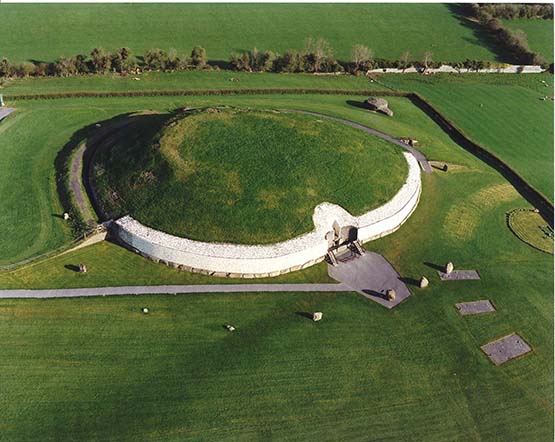 Newgrange in County Meath - 5000 years old, and eloquent evidence of the sophistication of Ireland of the time
Newgrange in County Meath - 5000 years old, and eloquent evidence of the sophistication of Ireland of the time
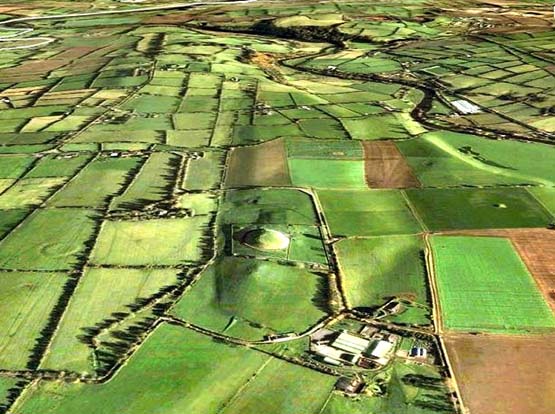
Newgrange’s location close to the River Boyne (top right) is a reminder that while basic river transport had become quite highly developed, in this era Irish seafaring was still in its earliest and most primitive stages despite the people’s ability to undertake the advanced calculations used in the construction of Newgrange.
So these were not a people who were just passing through. The earliest Irish were determined to make something special of their new home with some colossal and impressive sacred buildings and structures. To some extent this reflected the possibility that they were totally committed to creating a meaningful life in Ireland perhaps because they saw themselves as now marooned on it.
This sense of being marooned would have become embedded and emphasised in the compact family and tribal groups which very slowly spread across the island as a basic farming and hunting people. The inherited memories of the horror of the voyage to attempt to reach Ireland, in which many lives must have been lost at sea, would have been passed down from generation to generation, and we can be sure that the potential hazards of such an enterprise would lose nothing in the re-telling and embellishment of the ancient stories around the family hearth.
In other words, the longer your people have been in Ireland, then the greater would be your inherited sense of the risk in seafaring. Put another way, you could say that the very earliest Irish were not a seafaring people because the very earliest Irish mammies were absolutely determined that their sons were not going to seek a living on the dreadful sea. In the way of Irish mammies, they made sure that everyone knew this, and they have continued to do so to the present day.
If this emphasis on the adverse effect of inherited unhappy memories seems to over-state the case, consider the circumstances of the ancient people of the Canary Islands. When the Spanish voyagers first discovered the Canaries at a time not so very distant from Columbus’s voyages to America, they thought initially that the islands were uninhabited. It was only later that it was discovered that the highest mountain regions were home to an isolated people who were distantly related to the Berbers of North Africa.
In the remote past, these mountain people’s ancestors had somehow – possibly unintentionally – made the 62 mile voyage across from Africa. It is only eight miles further than the shortest distance between Wales and Ireland. But the seas are significantly warmer, which you’d expect to be a favourable circumstance for encouraging further voyaging. Yet having finally struggled ashore, those first Canary Islanders were very soon distancing themselves from the sea and seafaring.
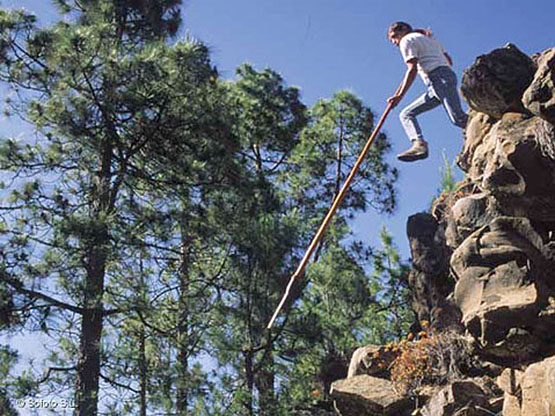 The Shepherd’s Leap (Salto del Pastor) of the Canary Islands. The earliest islanders in the Canaries turned their backs on boats and the sea so completely that they retreated away from the coasts and went to live in the mountains. There, they developed a unique way of life including this primitive pole-vaulting – now a traditional sport – in order to descend cliffs or traverse ravines
The Shepherd’s Leap (Salto del Pastor) of the Canary Islands. The earliest islanders in the Canaries turned their backs on boats and the sea so completely that they retreated away from the coasts and went to live in the mountains. There, they developed a unique way of life including this primitive pole-vaulting – now a traditional sport – in order to descend cliffs or traverse ravines
Any small enthusiasm they might have had for boats soon disappeared completely, such that they now have no shared knowledge or memory of boats at all. And up in the mountains, their most remarkable talent is the ability to pole vault down into or across the ravines – the Shepherd’s Leap - in order to travel about in their vertiginous homeland, which was seen as preferable in every way to the real dangers of seafaring.
In a Thomas Davis lecture for Seascapes a dozen or so years ago, I discussed the specialised nature of those whose primary interest in the early days of Irish settlement lay in seeing seafaring as a viable way of life. So relatively rare were such people that I reckoned at the time that this talent for exploiting the diverse wealth which the sea offered would provide them with useful survival mechanism for themselves and future generations of their families.
But I now realise that I got it totally wrong. Absolutely the opposite must have been the case. Once you and your people had got safely to Ireland in the first wave of settlers, the seafaring was still so basic and consistently dangerous that having nothing further to do with it was a much better way of ensuring the continuing survival of your genetic stock, whereas producing a family of would-be sailors could see the end of the line in a very short few years.
Although the popular view in Ireland is that our earliest ancestors must have sailed direct from Iberia, it seems to me that Western European seafaring would have been so primitive in those days ten thousand years ago that the first settlers must have voyaged across in nondescript vessels from the most easily reached part of the nearby British land, which is the large island of Islay off southwest Scotland.
As it happens, DNA testing on the current population of southwest Scotland indicates that they too have significant elements of our Iberian stock. Thus there is a shared gene pool, and the earliest Irish most likely came by the easiest route from Scotland, whose people in turn had travelled overland from Europe via England.
If that seems a bit hard to take for those of us who like to think that we’re essentially a Mediterranean people left out in the rain, that we’re essentially a formerly seafaring race who came directly by sea from our ancestral homelands in the Basque region, be consoled by the fact that many centuries later Scotland itself was to undergo conquest by invaders from Ireland of the Scoti tribe, who gave a new name to a country formerly dominated by the Picts.
However, that was very much later, when seafaring technology had greatly advanced, and people could regularly sail across the waters between Ireland and Scotland with some confidence. But when the earliest land-starved pioneers were contemplating crossing to Ireland from Scotland, they would have first looked for the shortest route. The absolute shortest distances between Scotland and northeast Ireland is in the North Channel between the Mull of Kintyre and Fair Head in County Antrim. There, the straight line distance is barely a dozen miles, yet you are facing one of the most tide-riven, roughest and coldest sea channels in Europe. And should you make it safely across, the landing at the nearest point on either side is decidedly difficult.
Further south, the shortest distance between the Mull of Galloway in southwest Scotland across the North Channel to northeast County Down is only 20 miles, but here again in early times the landings were inhospitable on either side, and the tides could be ferocious in their adverse impact.
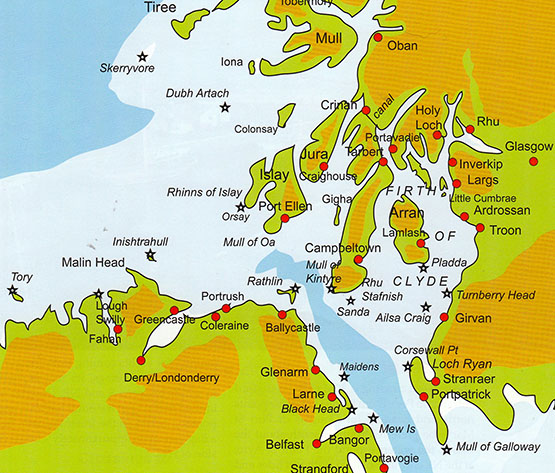
The crossings between Scotland and northeast Ireland which would have been faced by the earliest settlers. While the shortest distance between Kintyre and Fair Head to the east of Ballycastle is just over 12 miles, and the distance between Portpatrick and the nearest part of County Down is barely twenty miles, the entire North Channel between Rathlin Island and the Mull of Galloway is tide-riven, notoriously rough, and with the coldest sea temperatures on the Irish Coast. The earliest voyagers in very primtive boats would thus have had a better chance of a safe crossing, with more options as to their ultimate landfall, by setting off from Port Ellen in Islay, and having avoided the notorious tide race to the southwest of the Mull of Oa, then shaped their course to wherever the winds suited to make a landfall between Inishtrahull and Rathlin. The oldest human settlement in Ireland is at Mount Sandel near Coleraine. Plan courtesy Irish Cruising Club
But if you approached the Scotland-Ireland passage from the mainland of Scotland to the northeast, gradually working your way southwestwards through the southern Hebrides and gaining some seafaring experience with short inter-island hops until you were strategically placed at the natural harbour of what is now Port Ellen on the south shore of Islay, then the prospects were better. You might have still been all of 25 miles from Ireland, but it was a more manageable crossing. You had much greater choice in your possible destinations in making an Irish landfall, as you’d the entire Irish coast from Fair Head to Malin Head to aim for.
In reasonable weather, you could see where you were going, and with prevailing westerly winds there’d be a good chance it would be a relatively easy beam reach if you happened to have a primitive sailing rig, though the likelihood is the early boats were paddled, or rowed in primitive style.
Whatever the method of propulsion, there’s no disputing that one of the oldest sites of human habitation in Ireland is right in the middle of this northern coastline, at Mount Sandel on the River Bann in Coleraine. Yet no matter how much research and archaeology has been undertaken at Mount Sandel and at other ancient sites, no evidence of significant Irish human settlement has been found which goes back any further than ten thousand years.
As it happens, it was ten thousand years ago that mankind first developed the genetic mutation that enabled our ancestors to digest dairy products. But another five thousand years were to elapse before the first cattle were brought to Ireland to find that the place might have been invented for them, and cattle became a source and a measure of wealth. This new socioeconomic development pushed the sea and any form of seafaring even further down the social scale as a viable career option. Who would think of being a fulltime sea fisherman in a land noted as flowing in milk and honey? And even though water transport using rivers became a significant part of Irish life – notably in Fermanagh where the Maguires were to have a water-based mini-Kingdom - the sea was still viewed with suspicion, while the consumption of fish – whether from salt water or fresh – was regarded as socially inferior to eating meat.
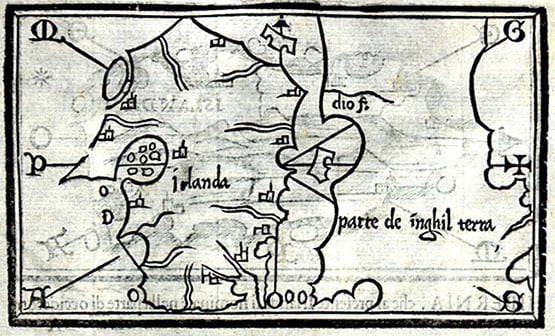
Mediaeval map of Ireland. It’s just possible that the island-studded inlet shown on the west coast is the Maguire-ruled Lough Erne, but more likely it is Clew Bay given prominence through Grace O’Malley.
It was only with improvements in seafaring technology and the general seaworthiness of ships that later generations and new groups of settlers might have brought a more positive attitude towards the sea. Then there was a period of about 1200 years – rudely ended by the first arrival of the Vikings around 795AD – when Ireland was remarkably free of invasions, yet enough marine technology had developed in the island for a brief flowering of Irish seafaring with the extraordinary voyaging of the Irish monks.
It has been argued by some scholars that there was no such person as St Brendan the Navigator. But undoubtedly there were great seafaring monks, and those of us who say that if it wasn’t St Brendan then it was somebody else of the same name will occasionally make the pilgrimage across from Dingle to rugged little Brendan Creek close under the west slopes of Mount Brandon on the north shore of the Dingle Peninsula, and wonder again at those Irish men of limitless faith setting out from this sacred spot into the great unknown in light but able boats.
But as it was seaborne asceticism which they sought rather than wealth, it was seen as a highly specialized and rather odd interest when most of the people were much more readily drawn to epic tales of profitable cattle raiding.
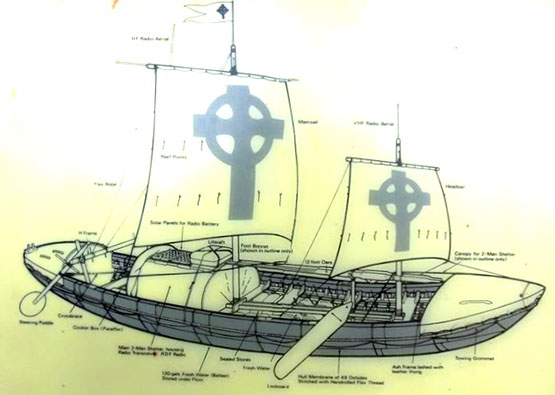
Details of Tim Severin’s oxhide “giant currach” with which – in 1976-77 - he showed that the supposedly mythical Transatlantic voyages of St Brendan the Navigator were technically possible. The St Brendan - which with Denis Doyle’s encouragement was built in Crosshaven Boatyard in 1975-76 – is now on permanent display at Craggaunowen in County Clare.
Then came the Vikings. Say what you like about the Vikings - and everybody has an opinion – but the reality is that their longships represented a quantum leap in naval architecture development. They brought state-of-the-art voyaging in versatile ships way ahead of anything seen before. Yet in time the Vikings were in their turn sucked into the Irish way of doing things, and far from turning Ireland into a seafaring nation, they seem to have literally burned their boats and set up home ashore, gradually absorbing the negative attitude towards the sea of their new neighbours, and taking on board the inevitable anti-seafaring attitudes of their new mothers-in-law
It wasn’t immediately as simple as that, of course. For a while, Ireland was the focal point of the Vikings’ sea trading routes along the coasts of western Europe, while Dublin had the doubtful distinction of being the biggest slave market in the constantly changing Viking western empire, which wasn’t really a territorial empire in the traditional sense, but was more a sphere of active influence and commercial and raiding activity. But it was undoubtedly a major centre which was totally dominated by all Viking activities, including ship-building, and the return to Dublin in 2006 of the 100ft Sea Stallion of Glendalough, a re-creation of one of the biggest Viking ships ever built (in Dublin in 1042), was a telling reminder of just how much Dublin had been to the fore in Viking life, while this video is a timely reminder of the great project completed in Roskilde ten years ago.
Inevitably, people of Viking descent were becoming a significant element in the Irish population, and even today we would naturally expect someone called Doyle to have something of the sea in their veins. Yet the Irish capacity for absorption of newcomers into the old ways of thinking has worked here too. The most common Irish surname today is Murphy. It means sea warrior. While those of us with maritime interests in mind would like to think it referred to an ancient tribe who went forth from Ireland to do successful battle on distant seas, we know in our heart of hearts that the Murphys are descended from warriors – mostly Vikings - who came in from the sea.
In time, they were enticed into domesticity by comely maidens who in due course became the formidable Irish mammies who prohibited any seafaring by their sons. Indeed, so far are most Murphys removed today from the sea that in some parts of the world the name is still a patronising nickname for the potato, something which is useful enough in its way, but its only maritime link is through fish and chips.
After the Vikings and then the Normans – who were really only Vikings with some slightly less rough French manners put on them – subsequent invasions were English-dominated, and the growth of British sea power was done in a manner which made sure that any Irish role in it was strictly of a subservient nature.

Rockfleet Castle in County Mayo, reputed deathplace of Grace O’Malley in June 1603. She was everything she shouldn’t have been, and in heroic style. She was Irish yet a mighty seafarer in command of her own ships, and a woman, yet a ruthless ruler of power and wealth who could combat men on equal terms.
Of course there were local heroes who tried to oppose this, the most renowned being Grace O’Malley, the Sea Queen of Connacht. But even when people of English descent tried to establish a separate Irish seafaring identity, as happened with the merchants of Drogheda, their aspirations would be slapped down by the dominant power and control from the government in London and the influence of the merchants of Bristol.
However, the government only had to look the other way for a moment before there was some local maritime enterprise was trying to flourish, and in the late 18th and early 19th Century the North Dublin smugglers, privateers and pirates of the little port of Rush in Fingal, people like Luke Ryan and James Mathews, were pace-setters in Europe and across the Atlantic, striking deals with Benjamin Franklin among others.
Depending on the state of international hostilities, sometimes their privateering trade could be quite open, and in Dublin the Freeman’s Journal of 23rd February 1779 reported that “we find the little fishing village of Rush has already fitted out four vessels, and one of them is now in Dublin at Rogerson’s Quay, ready to sail, being completely armed and manned, carrying 14 carriage guns and 60 of as brave hands as any in Europe”.
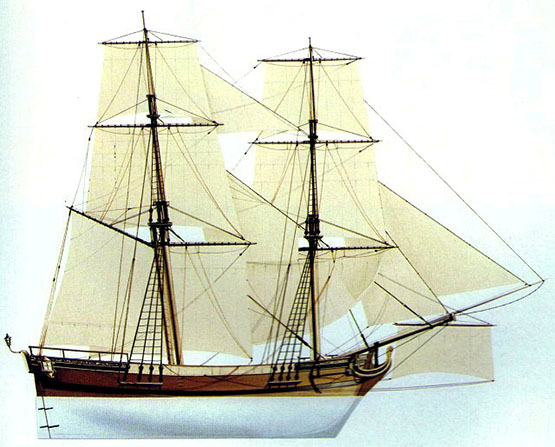
A late 19th century privateer, built for speed. When times were good for privateering, the little port of Rush in Fingal could provide a flotilla of these craft, which at other times could be kept hidden in the Rogerstown Estuary

The Admiral from Mayo. Being press-ganged by the Royal Navy was one of the many career-changing events which resulted in William Brown from Foxford becoming the founder-Admiral of the Argentine Navy.
But the majority of Irish seafarers were employed only in the humblest roles afloat, and often through the activities of the shore-raiding involuntary recruitment drives of the press gangs of Britain’s Royal Navy, However, this could produce some wonderful examples of unexpected consequences. The most complex was William Brown, of Foxford in Mayo, who had somehow risen to be a Captain in the American merchant marine when he was press-ganged into the Royal Navy, and after many vicissitudes, he ended up as a merchant in Buenos Aires. There, thanks to his unexpected acquisition of experience in naval warfare by courtesy of the Royal Navy, he became the founder of the Argentine Navy and an Admiral, as one does…..
Then there was the 18th Century Patrick Lynch of Galway, …….according to some stories, he was press-ganged. Be that as it may, the family made their fortune eventually in South America and a descendant, Patricio Lynch, owned the ship Heroina which played a significant role in Argentine history. The family continued to prosper in many directions, such that one decendant was Che Guevara, while another is the yacht designer German Frers, whose own pet yacht (which he gets little enough opportunity to use, as he is so busy designing boats for others) is called Heriona in honour of the family’s complex historic links through the sea with Ireland.
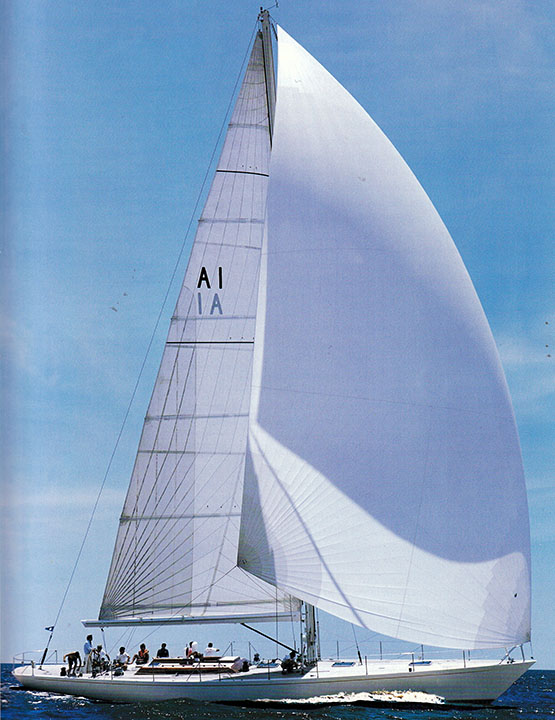
Yacht designer German Frers sailing his personal 74ft sloop Heroina in the River Plate. The boat is named in honour of the historic ship which belonged to his ancestor Patricio Lynch.
But while a very few of the young Irishmen press-ganged by the Royal Navy may ultimately have prospered in unexpected ways, the vast majority most definitely didn’t. Most came to a horrible end, while those who had managed to escape the press gangs’ clutches, together with the rest of the bulk of the native population, were reinforced in their inherited distrust of seafaring in any form.
Thus although we may now feel pride in the fact that the world’s first recreational sailing club was established with the Water Club of the Harbour of Cork in 1720, it’s difficult to avoid the conclusion that those great Munster landowners and merchants who founded it were partly doing it subconsciously just to show how very different they were from the ordinary run of Irish people in their attitude to the sea.
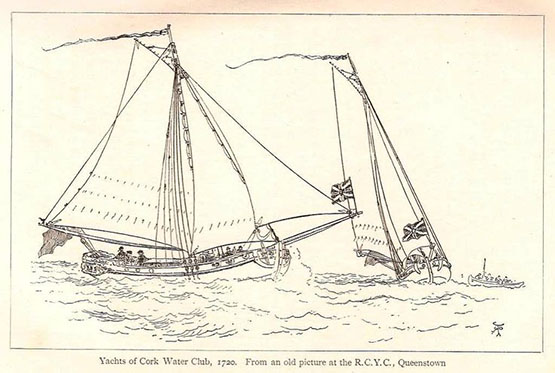
First instance of the “have nots” and the “have yachts”? The establishment of the Water Club of the Harbour of Cork in 1720 was a remarkable achievement, but if anything it emphasised the fact that the vast majority of Irish people had no enthusiasm or capability for the sea. Courtesy RCYC.
As for the official attitude when the Irish Free State finally came into being, its was so painfully sea-blind that we still need to draw a veil over its attitude, only noting that the first significant voyage under the new Irish ensign was made by one of that much-maligned class, a yachtsman. This was the great venture round the world south of the capes by Conor O’Brien of Limerick with his little Baltimore-built Saoirse between 1923 and 1925.
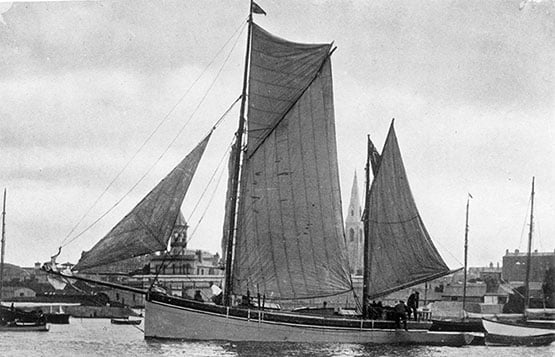
Conor O’Brien’s Saoirse departs Dun Laoghaire on her world- girding voyage on 20th June 1923.
O’Brien was to find Ireland so stultifying in its outlook after his return that he sailed away to live elsewhere, and we have to accept that for several decades the official approach reinforced the notion that being interested in the sea is un-Irish. So if we hope to change this attitude which still lingers today, a useful first step is to accept that for many of us, being non-maritime is the most natural thing in the world – we’ve had it instinctively from the very beginning, it’s in our handed-down and repeatedly-instilled inherited memories from the time when our most distant ancestors struggled ashore from battered little boats somewhere on the north coast, knowing that many others had died, and would die, trying to do the same thing.
Far from trying to pretend that this attitude doesn’t really exist, surely a much better way is to accept that it does, but that we’ve researched a perfectly valid explanation as to why this is so. Thus the way forward for Ireland to fulfill her maritime potential is to realize why this attitude is there in us, and take mature steps to offset it.
The fact is, in dealing with the sea, the Irish people have never had a level playing field. We’ve had to live with it and our inherited memories of being on it in very adverse circumstances. Unlike continental land dwellers, we have had no choice in the matter - we don’t see the sea as somewhere excitingly new with endless possibilities, we see it only with inherited distrust. And the determination of the current wave of walking migrants from the Middle East into Europe to attempt the sea crossing at only the narrowest part is further dreadful evidence of this.
But in another area of human endeavour, we’ve shown that we can do the business in competition with other nations. When aviation began to become part of everyday life a hundred years ago, it was unknown territory for all mankind. In terms of getting to grips with flying, it was a level playing field for all.
Yet here we are now in Ireland, an island in the Atlantic which is playing an extraordinarily active and central role in many aspects of aviation management and development, and certainly punching way above our weight. Looking at what we have been able to do in the air, it is surely time to look again at what we might do with the sea if we can look at it from a fresh perspective, and adapt the same can-do energies of the Irish aviation industry to the business of seafaring.
It’s time and more to shake off the old fears of the sea, while always maintaining a healthy respect for its undoubted power. That is best done by being in the vanguard of maritime technological development. And down around Cork Harbour, they’re doing that very thing. It’s just possible that, despite our ingrained anti-maritime attitude, we are beginning to view the sea in a more healthy and positive way. And it’s from our great southern port that we’re beginning to get inspiring leadership as the sea beckons us towards fresh opportunities.
So what, if nobody ever walked to Ireland? So what, if our distant ancestors had a very cold, very wet and very rough time getting here? It’s time to move on. Time to get over it. Time to start seeing the sea in a sensible way.

The little ship that carried the maritime hopes of a new nation. Conor O’Brien’s Saoirse in dry dock, showing the tough little hull that was able to register a good mileage most days in the Southern Ocean while still sailing in comfort. Yet when he returned to Dun Laoghaire in 1925 to complete his voyage with a rapturous homecoming reception, Conor O’Brien was soon to find that beneath the welcome there was increasing official indifference in the new Free State to Ireland’s maritime potential.
Afloat's W M Nixon RTE Thomas Davis Lecture Tonight Will Have A Follow-up Based On 'Mature Reflection'
#seascapes – Tonight's re-broadcast on RTE Radio 1 at 10.30pm of W M Nixon's maritime-themed Thomas Davis Lecture of 2002 is the final in the series of special repeats which have been transmitted to mark the 25th anniversary of the regular Seascapes marine programme, established in RTE's Cork studios by Tom MacSweeney, and continued weekly on Friday nights with Marcus Connaughton as presenter.
Nixon's thesis thirteen years ago was that, despite Ireland's island status, enthusiasm for sailing the sea – whether professionally or recreationally - has always been a minority interest. Yet despite its lack of broad popular support, specialist sailing such as the monastic voyages of seafaring saints like Columba of Iona or Brendan the Navigator were a significant thread in Irish life during one of the most civilised epochs in our history.
And then when recreational sailing began to develop as a recognisable interest in northwest Europe in the 17th Century or even earlier, a small section of the Irish population was to play a leading role in its development and codification.
Yet even within the families of some of the leading proponents of the new amateur sailing, there was a lack of understanding and support of what the Irish maritime pioneers were trying to achieve. Nixon quotes the case of a world-renowned Irish amateur voyager whose cousin – a man distinguished in the shoreside professional world – expressed the view that his rough seafaring relative would have had much more to show for his extraordinary life had he stayed quietly ashore, working steadily at his trained profession as an architect.
While he still holds many of the views expressed in this lecture more than a dozen years ago, W M Nixon admits that some of his thoughts on the relationship of the Irish and the sea have since, with "mature reflection", changed quite radically. He aired some of these thoughts at the Glandore Summer in July 2014, and they will be further developed in a new broadcast for Seascapes in the near future.
Seascapes On RTE Radio 1 Has Much To Celebrate After 25 Years
#seascapes – The maritime community in Ireland is a mystery to the vast majority of the rest of the population. Admittedly anyone Irish will sing enthusiastically about how good it is to be entirely surrounded by water. But for most folk among a people who like to think that they're basically rural even if the reality is they're increasingly urban, the sea is seen as no more than a useful barrier, while the coast is only briefly a fun place at the very height of a good summer.
The sea and the coastal interface are not seen as an exciting world in itself, a unique environment which deserves to be explored, enjoyed and utilised in practical and often beneficial ways. On the contrary, the popular view of the plain people of Ireland is that the less they know about the sea, the better. And the unspoken corollary of this is that anyone who seeks to go to sea for recreation is at best a bit odd, maybe even a misfit ashore, while those who work on the sea only do so because they couldn't get a job on land.
Here at Afloat.ie, in its various manifestations over the past 52 years, we've been trying to spread mutual understanding and useful information among the many and varied strands of those who go afloat for sport and recreation in Ireland and beyond. We know this is largely a matter of preaching to the converted. But we also try to do our bit to welcome those who may be newcomers to the world of boats, while remaining keenly aware of the drawbacks of over-selling our sport, our hobby – our obsession, if you wish.
Sailing and boating in Ireland can be rugged enough. Thus the sport in all its forms can only expand in a sustainable way if it attracts people who will themselves bring something positive to the party, for interacting usefully with boats is not a passive affair. And there has been a certain level of success. Over the years, while there was an understandable blip in boating numbers during the recent recession, the graph has been reasonably healthy when it's remembered that rival sport and entertainment attractions are proliferating all the time, while the increasing availability of holidays afloat in sunnier climates makes the promotion of boating activity within Ireland more problematic.
Fifty-two years ago, beginning a process of regular communication among Ireland's recreational boating community was quite a challenge. But it was a very straightforward project compared with inaugurating a regularly weekly broadcast maritime programme for all listeners on national radio in a country notably averse to the sea. Yet it all began 25 years ago, and it's still going strong.
So how do you celebrate 25 years of a niche radio programme, a little Irish maritime magazine of the air? It would be too much to expect a documentary on primetime television. And even an extra-long gala edition on the national radio airwaves at peak listening times might well be counter-productive. So it seems the answer is that the best way to celebrate 25 years of Seascapes on RTE Radio 1 is to publish a book well-filled with some of the key broadcasts with which it has been associated. And as those now-printed broadcasts include a maritime-themed series of the prestigious Thomas Davis Lectures, you mark the anniversary by sending out those as broadcasts again in their own right twelve years after their first transmission.
It may all sound almost devious, a matter of managing to slip the Seascapes celebrations in under the RTE management radar. But those of us who have been banging the maritime development drums for a very long time are well aware that, though the tide is definitely turning, there's still a huge underlying resistance to anything to do with the sea and boats, and it takes an element of cunning to get the message across such that, in time, the people are themselves singing from the same hymn sheet, and thinking it was all their idea in the first place.
But the founder of Seascapes 25 years ago, RTE's Cork reporter Tom MacSweeney, makes your average terrier look like a tired old dog. A sailing and maritime enthusiast himself even though his family had been from a non-maritime background, he had as a child in Cork been inspired by his grandfather's great respect for seafarers, and the vital task they performed in keeping Ireland connected with the rest of the world. He could see the sea all about us, and Cork is the most maritime of cities. So he just kept nagging RTE until they gave him a quarter of an hour once a week back in 1989 to put on a maritime programme for an island nation. And though it has been shifted around in the schedules, it is now a solid half hour every Friday night at 10.30pm, a worthy fulfilment of RTE's public service remit - you really do get a sense of Seascape's nationwide listening community, while podcasts make it more accessible than ever.
The sheer volume of material from all round Ireland's coasts, from our lakes and rivers, and from Irish seafarers abroad, is simply monumental, a treasure trove. So in producing the book (it's published by Liffey Press at €20 with all royalties going to the Lifeboat Service), they'd to wield a fierce scalpel. And though it includes the complete set of Thomas Davis lectures from twelve years ago, it's still of manageable size (in other words, you can read it in bed), while giving a good overview and flavour of the kind of material Seascapes broadcasts, and what we might call the house style.
In Tom MacSweeney's days of producing and presenting it from 1989 until he retired from RTE in January 2010, it has to be agreed that very occasionally the nagging which got Seascapes its slot in the first place sometimes spilled over onto the airwaves in the programme itself. Okay, we all know that Ireland is not as sea-minded as it might be. But things are slowly improving in this, and they might improve more quickly if the maritime movement relied more on the path of gentle encouragement and inspiring example rather than constantly reiterating the tedious refrain of "the government should do this, the government should do that....."
From time to time, I have to confess I thought the worst possible thing was to get the government involved at all, having seen what the official encouragement and enforcement of the Irish language had achieved since the establishment of the state. There'd be occasions when you'd think the best way to turn the Irish into a nation of doughty sailors would be to declare seafaring illegal. The people would have taken to boats in their droves....But nevertheless the tide is slowly but definitely turning, and in today's less frenetic atmosphere of businesslike maritime promotion and development, we're becoming more comfortable in our relationship with the sea.

Man of the sea. Rear Admiral Mark Mellett DSM on exercises with the Naval Service off the Cork coast.
So it was entirely appropriate that, in the launching of the Seascape's compendium Sailing By, the main speaker in both the Cork Harbour Commissioners' building on the Friday night (November 28th), and in the National Maritime Museum in Dun Laoghaire on Monday, was Rear Admiral Mark Mellett DSM, our most distinguished navy man, who has risen to the august heights of Deputy Chief of Staff of the Defence Forces.
If you requested Central Casting to provide an Irish Admiral who conveys the expected air of competence with the necessary gravitas and presence, while still having that essential Irish twinkle, then they'd send you Mark Mellett. We'd most of us heard of his steady rise through the senior ranks, but for many of us in the National Maritime Museum on a damp December night, it was the first experience of seeing Admiral Mellett in a professional and public capacity. For people from a very wide range of interests and activities in the maritime sphere, it was very encouraging – we feel we now have a spokesman who can ably represent us at every level, however formal or high powered, while at the same time retaining the human touch.
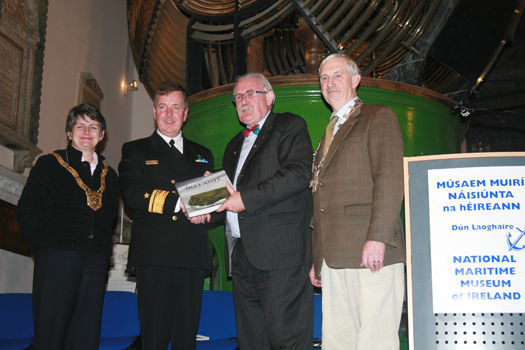
Top people at the launching of the Seascapes book Sailing By are (left to right) Cllr Marie Baker (Cathaoirleach of Dun Laoghaire-Rathdown County Council), Rear Admiral Mark Mellett DSM (Deputy Chief of Staff , Defence Forces), Marcus Connaughton of Seascapes, and Richard McCormick, President of the National Maritime Museum. Admiral Mellett is being presented with the book The Atlantic Coast of Ireland, as he already has his own copy of Sailing By – he wrote the foreword.
His enthusiasm is palpable, and he provided a foreword for the book which speaks from the heart, yet provides a practical and businesslike outlook. In fact, that was the flavour of the evening in the National Maritime Museum, as it was hosted by Richard McCormick, the recently elected President of the National Maritime Museum, and the speakers included the Cathaoirleach of Dun Laoghaire-Rathdown County Council, Cllr. Marie Baker, and Tom McGuire, head of RTE Radio 1, who knows better than anyone just what has been needed to keep Seascapes on the airwaves for 25 years.
Most of all it has of course been the sheer dogged determination of Tom MacSweeney working on his own as producer and presenter in RTE's Cork studio, followed by his successor Marcus Connaughton, who came in as producer when the Thomas Davis Lectures were added to an already almost impossibly demanding schedule in 2002, and stayed on to become presenter eight years later.
They're two very different people. Tom is so involved and enthusiastic that occasionally his own personality, opinions and attitudes cloud the issue. He's a complex man with many interests, not least of them being a national Vice President of the St Vincent de Paul Society. But as regular visitors to Afloat.ie will know, he continues to broadcast his own maritime programmes through community radio, and he's a much-sought-after speaker on sea matters. Recently, he gave a sold-out talk - How Stands Our Island Nation? - to the Dublin Bay Old Gaffers Association in the Poolbeg Y&BC, and while he had the usual serious message, it was leavened by his sharp wit, with the laugh of the evening being provided by his reading of the pained official letter from an Irish Lights Manager complaining about the sheer incompetence and slovenly carelessness of Brendan Behan when he was employed as a painter renovating the St John's Point lighthouse in County Down.
That said, it was a telling lesson in the importance or otherwise of maritime affairs in Ireland's national and cultural life in times past, that the story of a noted playwright making a complete hames of painting a lighthouse was something you knew would register more readily with a general audience than anything of more direct nautical interest, and it is an awareness of the need to reach out gently to the general public which sets the tone of Marcus Connaughton's presentation of Seascapes.
He arrived in the job first as producer, and then as producer/presenter, with no personal baggage in maritime matters. His background was in music production and public relations, and a couple of years ago he brought seventeen years of research and writing to a successful conclusion with the defining biography of Rory Gallagher. But gradually he has become absorbed in and intrigued by the world of boats and the sea. As one of the speakers on Monday night put it, one of the most quietly impressive peformances you'll see is Marcus – who is by no means a small man – sidling into the crowd at some maritime gathering, armed with microphone and recorder, ready and willing to give a voice to the voiceless.
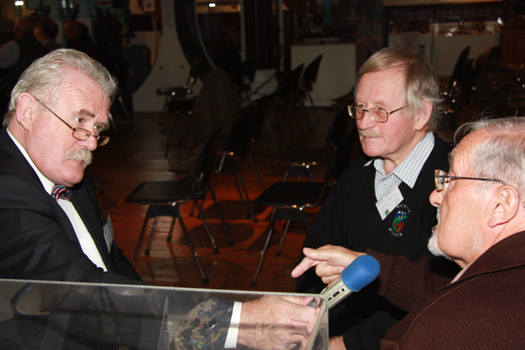
Man at work – Marcus Connaughton records the memories of Alan Martin and Jimmy Carthy of the Dublin Dockworkers Preservation Society
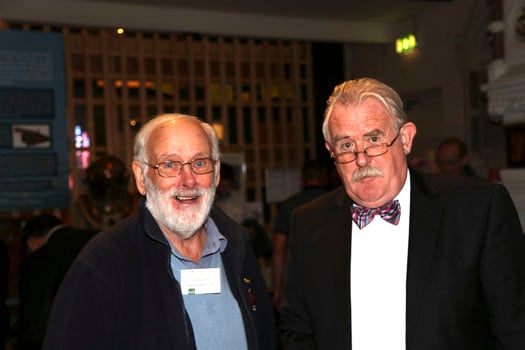
Tim Magennis (left) President of the Dublin Bay Old Gaffers Association, with Marcus Connaughton. Once upon a time, they were work colleagues in the PR Department of Bord Failte

The book launch begins to become a party – Con Murphy of the National YC (left) and Brian Craig of the Royal St George YC getting their copies of Sailing By signed by Marcus Connaughton in the National Maritime Museum. Photo: W M Nixon
The changeover to a new presenter was fairly gradual, but very marked in one thing – he changed the signature tune. When Seascapes started in 1989, they simply borrowed the music which precedes the BBC Shipping Forecast, Ronald Binge's "Sailing By".
"Sailing By" in almost any form is the sound of syrup being poured over sugar lumps, but some folk loved it, so the change to the brisk tone of Simon Mayer's The Reel Thing wasn't universally popular, even if welcomed by those of us trying to cut down on the sucrose.
Yet it's surely an appropriate 25th anniversary sweetener that the published compendium of Seascapes stories is titled Sailing By, and the cover is a fine photo of the renowned pilot cutter Jolie Brise sailing by the Fastnet Rock. It was taken by Brian Carlin of Tralee, who subsequently went on to be the award-winning photographer aboard the Volvo 65 Team Vestas, which unfortunately managed to do some excessive impactive navigation off Mauritius during the Volvo World race last weekend. It was certainly not the photographer's fault, but it heightened the sense of an Irish maritime community worldwide that at Monday night's gathering, Marcus was able to tell us that not only was Brian all right, but that in contacting his father to say so, he requested that the message be passed on to Seascapes as soon as possible.
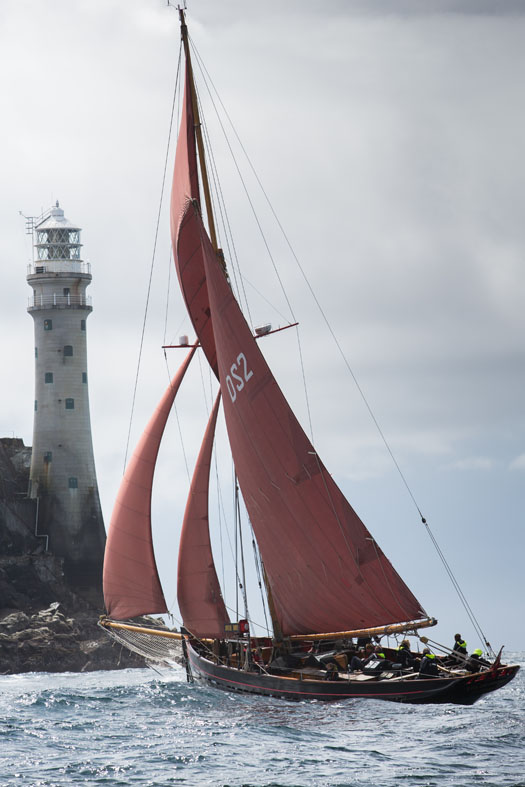
One of award-winning photographer Brian Carlin's studies of Jolie Brise sailing by the Fastnet Rock. Photo: Brian Carlin
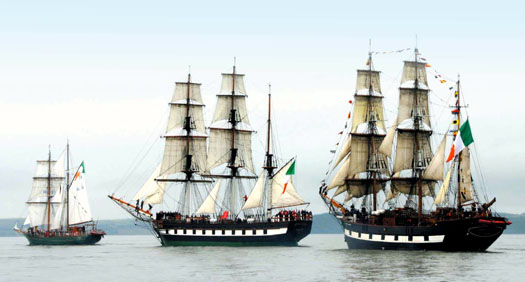
The top moment – it's 2005, and the Seascapes team are on board Asgard II as she leads the Dunbrody of New Ross, and the Jeanie Johnston of Tralee, in the Parade of Sail at the Tall Ships visit to Waterford. Photo: Dave Osborne
As for Marcus's own special recollections of his years with Seascapes, we allowed him six and he ranked them: (1) Being on Asgard II in Waterford with the Tall Ships in 2005, (2) at sea off Hook Head with Martin Colfer amidst enormous schools of lively dolphins, (3) in Galway during both Volvo visits, (4) being far up his beloved Munster Blackwater beyond Ballinatray at the top of the tide, (5) celebrating 25 years of the Killybegs Fishermen's Association at a monster party in the great Donegal port, and (6) being in the renovated National Maritime Museum in Dun Laoghaire when it was re-opened by President Michael D Higgins.
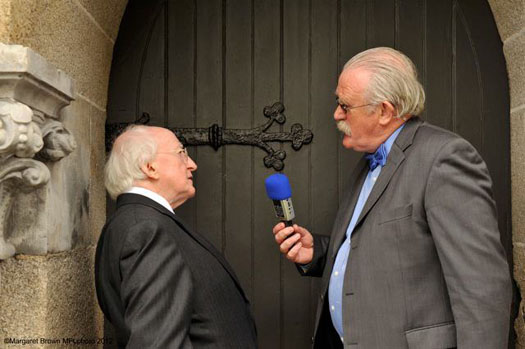
Presidential thoughts of the sea and seafaring in Ireland – Seascapes interviews President Higgins after he has re-opened the restored National Maritime Museum in Dun Laoghaire. Photo: Margaret Brown
Seascapes was of course broadcast as usual last night at 10.30pm, and Marcus Connaughton will be signing copies of Sailing By in Waterstones in Cork this afternoon from 2.0pm to 5.0pm. The first of the six Thomas Davis lectures from 20012 – Paddy Barry's lyrical account of sailing round Ireland – will be broadcast on Friday December 19th, and they'll continue weekly until the final one on February 6th, which is my own item about why most people in Ireland think sailing enthusiasts are so odd. As mentioned at the Glandore Summer School in July, I've changed my mind about some aspects of that, and I'll probably have changed it yet again when Marcus provides me with the space for further thoughts on the matter on Seascapes some time after February 6th.
But meanwhile, happy birthday to Seascapes – you provide a wonderful example of genuine public service broadcasting.
Naval Service’s Flag Officer Commander Interviewed on ‘Seascapes’
#NavyInterview – Commodore Mark Mellett, Flag Officer Commanding of the Naval Service will give an interview to be broadcast on RTÉ Radio 1's 'Seascapes' this Friday 20 September (22.30hrs).
Seascapes the maritime programme presented by Marcus Connaughton, is to focus on Mellet in a wide-ranging interview covering the history of the naval base on Haulbowline Island, the role of the Naval Service, new technologies, IMERC and the National Maritime College of Ireland (NMMI).
Also to be discussed will be the overall fleet. Afloat.ie adds that the broadcast coincides with L.E. Emer's last ever patrol which is scheduled to be completed that same day when she arrives to the naval base in lower Cork Harbour.
The Verolme Cork Dockyard built (P21) OPV is then to decommission following a career spanning 35 years.
An extended version of the interview with Mellett can also be heard on Podcast also on Friday afternoon in advance of the radio programme.
Heritage Day 2013: Port of Cork HQ Tours & 'Seascapes'
#HeritageDay – Heritage Day 2013 is next Saturday 17 August and marks the start of National Heritage Week which runs to the 25 August.
As part of the Heritage Day, there will be an illustrated talk by RTE Radio 1 Seascapes presenter/ producer Marcus Connaughton.
The talk will be about the maritime heritage of our seafarers and maritime explorers who sailed the World's Oceans. "Maritime Heroes of An Island Nation- featuring Edward Bransfield; Tom Crean; Admirals Barry and Brown; John Philip Holland; Shackleton and many others."
This FREE event will commence at 2pm in the Port of Cork Boardroom, should you wish to attend, bookings can be made by contacting Sara Mackeown on (021) 462 5375.
On the same day the Port of Cork's Custom House Building will be open to the public between 11am – 4pm. Note, there is no parking available.



























